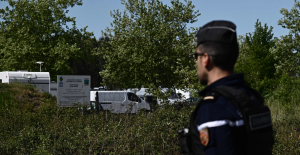the WASHINGTON - A mysterious "ripple" in the fabric of space-time has been detected by the Laser Interferometer Gravitational-Wave Observatory (LIGO) in the United States. It happened last Tuesday when an unusual and unexpected gravitational wave has hit the Ground and seemed to be coming from somewhere near the red supergiant in the constellation Orion, the star Betelgeuse. At the moment scientists can not say with certainty what has caused this gravitational wave, or if it is 100 per 100 of a gravitational wave is authentic, and this is because of its unusual nature. There is also the possibility that it is a "false positive". So far the waves detected by LIGO have all been linked to significant events such as the collision of two black holes or the merger of neutron stars, but this is a "new wave".
This type of "explosion", according to the scientists, it may be connected to phenomena such as a supernova or gamma-ray bursts. The hypothesis that this could be linked to a possible explosion of a supernova has led some astronomers to think if they were about to witness the death of the supergiant red Betelguese. The star has about eight million years and it is expected that in the next 100 thousand years to become a supernova. Recently the star has behaved in a strange way, becoming much more weak compared to when I started the observations modern.
The astronomer Andy Howell said that it is unlikely that Betelgeuse might explode. According to the expert, there was a significant increase in the detection of neutrinos, something that you would expect to see if a star becomes a supernova.
astronomers have already rotated their telescopes in the area of the sky where they were detected gravitational waves in the hope of discovering the true cause. According to Jessie Christiansen, a scientist at Nasa, even some of the larger telescopes they will change their study objective. The exact location has not yet been identified because of the unusual nature and the unexpected explosion, but LIGO expects to find more details in the coming days or in the next few weeks. At the time LIGO describes this most recent recognition as "gravitational waves crashing in the night". Scientists say that there is not a model that would help to confirm if it is a supernova, so it could even be something different.
This type of "explosion", according to the scientists, it may be connected to phenomena such as a supernova or gamma-ray bursts. The hypothesis that this could be linked to a possible explosion of a supernova has led some astronomers to think if they were about to witness the death of the supergiant red Betelguese. The star has about eight million years and it is expected that in the next 100 thousand years to become a supernova. Recently the star has behaved in a strange way, becoming much more weak compared to when I started the observations modern.
The astronomer Andy Howell said that it is unlikely that Betelgeuse might explode. According to the expert, there was a significant increase in the detection of neutrinos, something that you would expect to see if a star becomes a supernova.
astronomers have already rotated their telescopes in the area of the sky where they were detected gravitational waves in the hope of discovering the true cause. According to Jessie Christiansen, a scientist at Nasa, even some of the larger telescopes they will change their study objective. The exact location has not yet been identified because of the unusual nature and the unexpected explosion, but LIGO expects to find more details in the coming days or in the next few weeks. At the time LIGO describes this most recent recognition as "gravitational waves crashing in the night". Scientists say that there is not a model that would help to confirm if it is a supernova, so it could even be something different.
"The Republic will fight always in defense of the freedom of information, to its readers and to all those who have at heart the principles of democracy and civil coexistence"
Carlo Verdelli SUBSCRIBERS TO REPUBLIC © Reproduction reserved Today on Francis: with Ratzinger, the case is closed Agreement between the Usa and China, Trump: “the Covenant epoch-making” And hoped in the help of Xi to win back the election Duties, now it's up to Europe: but with Beijing's more powerful than the negotiation will be difficult Before the italians Bibbiano tired of the mud: “they treat Us like Cogne. But it is the electoral campaign”the Republic

 His body naturally produces alcohol, he is acquitted after a drunk driving conviction
His body naturally produces alcohol, he is acquitted after a drunk driving conviction Who is David Pecker, the first key witness in Donald Trump's trial?
Who is David Pecker, the first key witness in Donald Trump's trial? What does the law on the expulsion of migrants to Rwanda adopted by the British Parliament contain?
What does the law on the expulsion of migrants to Rwanda adopted by the British Parliament contain? The shadow of Chinese espionage hangs over Westminster
The shadow of Chinese espionage hangs over Westminster Colorectal cancer: what to watch out for in those under 50
Colorectal cancer: what to watch out for in those under 50 H5N1 virus: traces detected in pasteurized milk in the United States
H5N1 virus: traces detected in pasteurized milk in the United States What High Blood Pressure Does to Your Body (And Why It Should Be Treated)
What High Blood Pressure Does to Your Body (And Why It Should Be Treated) Vaccination in France has progressed in 2023, rejoices Public Health France
Vaccination in France has progressed in 2023, rejoices Public Health France The right deplores a “dismal agreement” on the end of careers at the SNCF
The right deplores a “dismal agreement” on the end of careers at the SNCF The United States pushes TikTok towards the exit
The United States pushes TikTok towards the exit Air traffic controllers strike: 75% of flights canceled at Orly on Thursday, 65% at Roissy and Marseille
Air traffic controllers strike: 75% of flights canceled at Orly on Thursday, 65% at Roissy and Marseille This is what your pay slip could look like tomorrow according to Bruno Le Maire
This is what your pay slip could look like tomorrow according to Bruno Le Maire Sky Dome 2123, Challengers, Back to Black... Films to watch or avoid this week
Sky Dome 2123, Challengers, Back to Black... Films to watch or avoid this week The standoff between the organizers of Vieilles Charrues and the elected officials of Carhaix threatens the festival
The standoff between the organizers of Vieilles Charrues and the elected officials of Carhaix threatens the festival Strasbourg inaugurates a year of celebrations and debates as World Book Capital
Strasbourg inaugurates a year of celebrations and debates as World Book Capital Kendji Girac is “out of the woods” after his gunshot wound to the chest
Kendji Girac is “out of the woods” after his gunshot wound to the chest Skoda Kodiaq 2024: a 'beast' plug-in hybrid SUV
Skoda Kodiaq 2024: a 'beast' plug-in hybrid SUV Tesla launches a new Model Y with 600 km of autonomy at a "more accessible price"
Tesla launches a new Model Y with 600 km of autonomy at a "more accessible price" The 10 best-selling cars in March 2024 in Spain: sales fall due to Easter
The 10 best-selling cars in March 2024 in Spain: sales fall due to Easter A private jet company buys more than 100 flying cars
A private jet company buys more than 100 flying cars This is how housing prices have changed in Spain in the last decade
This is how housing prices have changed in Spain in the last decade The home mortgage firm drops 10% in January and interest soars to 3.46%
The home mortgage firm drops 10% in January and interest soars to 3.46% The jewel of the Rocío de Nagüeles urbanization: a dream villa in Marbella
The jewel of the Rocío de Nagüeles urbanization: a dream villa in Marbella Rental prices grow by 7.3% in February: where does it go up and where does it go down?
Rental prices grow by 7.3% in February: where does it go up and where does it go down? Europeans: “All those who claim that we don’t need Europe are liars”, criticizes Bayrou
Europeans: “All those who claim that we don’t need Europe are liars”, criticizes Bayrou With the promise of a “real burst of authority”, Gabriel Attal provokes the ire of the opposition
With the promise of a “real burst of authority”, Gabriel Attal provokes the ire of the opposition Europeans: the schedule of debates to follow between now and June 9
Europeans: the schedule of debates to follow between now and June 9 Europeans: “In France, there is a left and there is a right,” assures Bellamy
Europeans: “In France, there is a left and there is a right,” assures Bellamy These French cities that will boycott the World Cup in Qatar
These French cities that will boycott the World Cup in Qatar NBA: the Wolves escape against the Suns, Indiana unfolds and the Clippers defeated
NBA: the Wolves escape against the Suns, Indiana unfolds and the Clippers defeated Real Madrid: what position will Mbappé play? The answer is known
Real Madrid: what position will Mbappé play? The answer is known Cycling: Quintana will appear at the Giro
Cycling: Quintana will appear at the Giro Premier League: “The team has given up”, notes Mauricio Pochettino after Arsenal’s card
Premier League: “The team has given up”, notes Mauricio Pochettino after Arsenal’s card


















